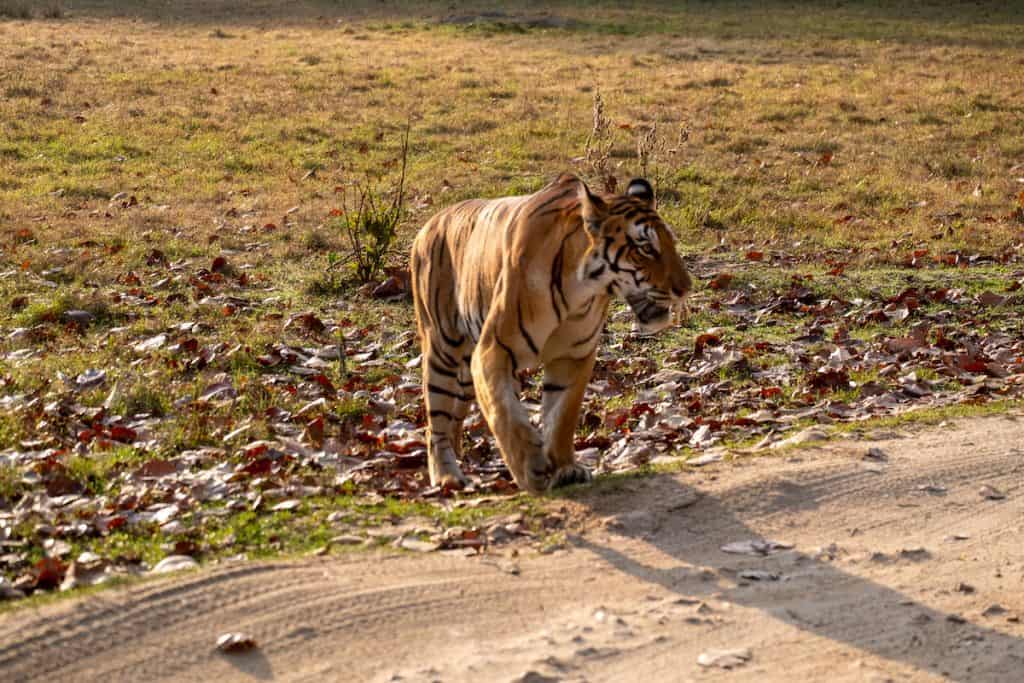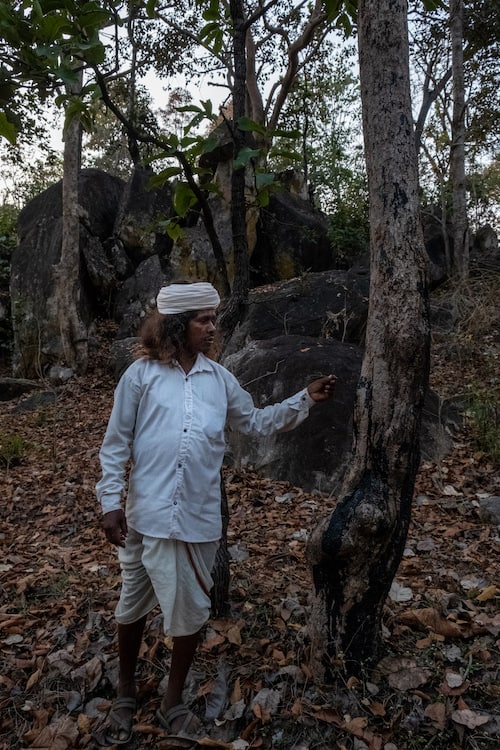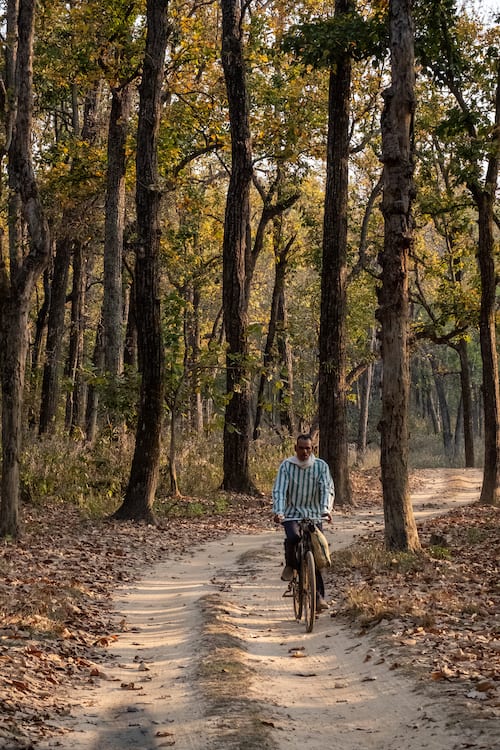Are you wondering where to go for the best tiger safari in India? Or do you crave connection with India’s beautiful forests and simply want to get away from it all? Kanha tiger reserve is one of the best places to go on safari in India – for its beautiful forests, high tiger density, and commitment to restoring relationships with indigenous communities who serve as guardians of this special land. Read on to find out how you can experience the magic of Kanha for yourself.
This post contains compensated affiliate links. For more info and my full disclosure, please read here.
An Introduction to Kanha National Park, Madhya Pradesh
Nestled in the heart of central India, in the state of Madhya Pradesh, Kanha is relatively little known among international visitors to India. With most opting for convenient – if over-crowded – tiger safaris in Ranthambhore, Rajasthan, the true heartland of the Indian jungle remains a treasure for the more committed traveller.
Kanha tiger reserve is known as the creme-de-la-creme of Indian national parks and tiger reserves. Not only is the park home to one of the higher tiger population densities (meaning your chances of actually sighting one are good), but its combination of grassland meadows and saal forests make for one of the most stunning safari backdrops you could imagine.
To access Kanha, the nearest cities are Jabalpur or Nagpur (across the border in Maharashtra) – a 2 and 5 hour drive respectively.
I travelled to Kanha with Footloose Journeys – a grassroots Indian operator based out of Maharashtra who pride themselves on sustainable travel, positive impact tourism that is a win for all involved, and affordable, accessible safaris for those who want to connect more deeply with nature and wildlife.
(Note – for Safaris in India, you definitely need to book through a local operator – organising safaris, permits, guides and naturalists by yourself is a tall order and not recommended for foreigners to do alone – which is why I recommend going through a company such as Footloose).

The Land of the Tiger – Conservation
A little known fact about India is that it’s home to 7% of the world’s remaining biodiversity.
Considering the size of the sub-continent, that percentage would ideally be even higher, but the fact remains – India is a centre stage when it comes to preserving what remains of our incredible wildlife here on earth, and that is never more true when it comes to protecting the world’s remaining big cats.
Established in 1971, Project Tiger has been critical in driving tiger conservation in India, and the state of Madhya Pradesh is home to the largest population of tigers in India, as well as being at the forefront of award winning responsible tourism efforts.
Not only has Kanha tiger reserve been at the forefront of creating responsible tourism models, they are also the first national park in India to launch an initiative to encourage women to work as naturalists and set up a dedicated training programme for women who wish to work in wildlife tourism in India (if you’ve been to India, you’ll have noticed that 99% of tourism guides are male).

Providing safe territories for the Bengal Tiger to thrive in 21st century India is no small feat. Tigers require huge territories in order to breed and thrive, and the competition between humans and wildlife for every square foot of space has never been more intense. When it comes to building new highways vs protecting land for wildlife, the former usually wins. Fortunately, with new innovations such as elevated highways and wildlife crossings in Madhya Pradesh, it does seem that a win-win solution is possible, with the right commitment.
With the proven economic value of wildlife tourism – including tiger safaris – and the headlines attracted by conservation of India’s hero species (the tiger), fortunately the case for conservation is becoming ever more compelling – and important, and is attracting more attention.
Planning a tiger safari for your India trip? Read my top tips for tiger safaris in India here!


Kanha’s Indigenous Communities – The Baiga Tribe
One of the tragedies of tiger conservation in India has been that very often the indigenous communities that are closest to the land and living in a way that is harmonious with nature, are forcibly relocated outside of national park territory in order to protect the wildlife.
It’s a double edged sword. On one hand, the humans that have the most sustainable lifestyle are having their lands taken away from them. On the other, tribal communities have struggled in many areas as their lifestyle is eroded, and increasingly they become prey to the influence of alcohol and offers of wealth from middle-men working for poachers outside of India.
The Baiga tribe are one of the remaining tribal communities who were initially forcibly relocated outside of the ‘core’ zones of Kanha national park, but have now been granted lands in the buffer zones and around, and are now being included in Madhya Pradesh tourism’s drive for more community-driven, sustainable tourism efforts.
Along with the Gond tribal community, they are one of the main tribal groups native to this area of Madhya Pradesh and the neighbouring border area with Maharashtra.

The Baiga community are known for their way of life that is closely connected with nature. Taking only what they need to sustain, most Baiga’s have been against tilling the land on a widespread scale, instead planting small areas of crops to feed their community only.
There is an honouring of nature that is inherent in all of their practices: From worshipping trees in the forest such as the crocodile bark tree, to working with plants for medicinal use, to eating off leaves that can be composted each day, and weaving baskets for fishing.
The Baiga people are true representatives of those living a “zero waste lifestyle” on the planet — but with none of the marketing and greenwashing.

Working with the Baiga Community in Kanha – Community Tourism for the Future
There are several ways to learn about Baiga culture during your time in Kanha national park. As part of my trip with Footloose Journeys, we had several opportunities to engage with the local Baiga chief as well as visit one Baiga community in their village.
An artist and guide to the Baiga way of life – Ashish bhai – who has studied the Baiga way of life for decades, has set up an art gallery showcasing the Baiga philosophy, portraits of the Baiga tribe, and their connection with earth, which tourists can visit on prior arrangement. His work demonstrates the danger of the dwindling connection between humanity and the earth, and how much we can learn and remember from the Baiga life philosophy.
Baiga chief Son-Say led us on a walk through the forest on our first evening in Kanha, pointing out many of the different plants and trees that play a part in Baiga daily life. The Baigas know the forest like the back of their hand, walk barefoot, and it was once said – could summon tigers at will.
The next day we visited their village and joined in activities from weaving baskets to pinning bowls from leaves and twigs, to sampling the local Mahua (a local flower) alcohol brewed by the Baigas.
What struck me most hearing about the Baiga way of life was the remembered held wisdom about the interweaving of natures’ cycles and the human cycles of life.
The Baiga people have one dance.
The same dance is performed for birth, marriage, death and everything in between. A marking of each stage of life as a celebration as well as an ending.
The Baiga people are also aware of the wisdom of not holding any emotions in. Son-Say explained in great detail that when emotions are held in the body, they cause dis-ease. And so the Baiga will always share what they are feeling, un-reservedly.

Responsible Community Tourism with the Baigas in Kanha
The success of any community tourism model is reliant on it being a win-win for all parties.
Travel along any road to near Kanha and around in Madhya Pradesh and you’ll see signs to “Baiga Villages” where you can go and watch dance performances. While any of these are arguably ways to support the continuation of Baiga culture, as usual it is important to do your due dilligence about where you go before hand.
Footloose Journeys have invested years in developing relationships with Ashish bhai and Son-Say, the Baiga chief we met, as well as the rest of the village we went to. In a world where indigenous culture is all too often something that is regarded as “exotic” or entertainment, it’s important to support efforts where there are genuine, mutually beneficial relationships in place.
Like many tribal communities around the world, the Baiga are not without their challenges. From encroaching western culture eroding their old tried and tested way of life, to alcoholism and the invasion of 5G, it continues to be the greatest irony that “modern” society destroys those ways of life that are in the greatest harmony with our planet.
The job of community based tourism is to restore the wisdom of indigenous culture to the pedestal that it should be on for the rest of us to imitate.
You can venture along the Baiga trails for yourself on this trip with Footloose Journeys.

Want more tips planning your India trip? Read more on Soul Travel India:
In search of Rajasthan’s Leopards in Jawai